Senigaglia family
The Senigaglia family (sometimes spelt Sinigaglia) is an Italian Jewish family, whose origins can be traced back nearly 800 years, the period between the High Middle Age and the Renaissance.
Origins
Possible Spanish origin
One theory claims a Spanish origin, forming the hypothesis that they fled Spain because of the Inquisition. However, 22 years before 1492 (year of the Spanish expulsion), they were already settled in Italy, probably at Senigallia. Apart from the date problem, it seems difficult to believe that families running away from the Holy Inquisition and the Vatican, end up in a town run practically by the pope himself; whether it was Pope Alexander VI from the Borgia family, of Spanish origins, or Julius II from the Della Rovere family.
Possible Roman origin
Another more credible theory claims a Roman origin. In 1215, the Fourth Council of the Lateran wrote the following:
Canon 67. Jews and excessive Usury.
The more the Christian religion is restrained from usurious practices, so much the more does the perfidy of the Jews grow in these matters, so that within a short time they are exhausting the resources of Christians. Wishing therefore to see that Christians are not savagely oppressed by Jews in this matter, we ordain by this synodal decree that if Jews in future, on any pretext, extort oppressive and excessive interest from Christians, then they are to be removed from contact with Christians until they have made adequate satisfaction for the immoderate burden. Christians too, if need be, shall be compelled by ecclesiastical censure, without the possibility of an appeal, to abstain from commerce with them. We enjoin upon princes not to be hostile to Christians on this account, but rather to be zealous in restraining Jews from so great oppression. We decree, under the same penalty, that Jews shall be compelled to make satisfaction to churches for tithes and offerings due to the churches, which the churches were accustomed to receive from Christians for houses and other possessions, before they passed by whatever title to the Jews, so that the churches may thus be preserved from loss.[1]

During the subsequent centuries a number of Roman Jewish families left Rome on their own, or were encouraged by the Church to go to different towns or villages to establish small usury banks (with the purpose to substitute Christians in that line of business). They traveled choosing the Via Salaria or the Via Flaminia, taking along with them their tradesman abilities (with the corresponding family names, respectively): Orefice, Tessitori, Tintori, Della Seta (Goldsmith, Weaver, Dyer, Silk).
Other possible origins
Other possible origins are mixed in the melting pot of those troubled years:
- Ashkenazi Jews came from German-speaking countries, after the 1348 black plague (that Jewish communities have been accused of spreading, and for which many have been burnt alive). The individuals and families lucky enough to have survived moved to Venice and to Ancona, probably because the proximity of water made them safer.
- Sephardic Jews (the word derives from "Spain", Sepharad in Hebrew), expelled from Spain in 1492, started a long migration through Portugal and Northern Europe arriving at Livorno and later in the 16th century reaching the Marche.
Arrival in Senigallia
Chronology of Senigallia
- 1306: The town was conquered by Pandolfo Malatesta
- 1355-57: ownership returned to the Vatican with the help of cardinal Albornoz
- 1445: Popes Eugene IV and Nicholas V confirmed the ownership as vicariate to Sigismondo Pandolfo Malatesta[2]
- 1459: direct ownership of the Church due to a debt of Malatesta
- 1462: Malatesta tried to reconquer the town but he was defeated in the battle of the Cesano by Federico from Montefeltro
- 1462-64: ruled by Antonio Piccolomini, then back to the Church
- 1474: given by Pope Sixtus IV to his nephew Giovanni della Rovere who became Lord of Senigallia and of the Vicariate of Mondavio. It belonged to the same family until 1631. Decrees against the Jews.
- 1493: Giovanni Della Rovere founded the Fair of San Francesco
- March 1502: Pope Alexander VI confirmed the investiture to the twelve-year-old heir of Giovanni, Francesco Maria I Della Rovere
- 31 December 1502: Cesare Borgia, Duke of Valentinois, invaded Senigallia
- 31 October 1503: Cardinal Giuliano Della Rovere was elected Pope as Julius II: Cesare Borgia was imprisoned and Francesco Maria I obtained back the control of the town. (Imposition of the yellow badge to the Jews)
As a consequence of the marginalization of the Jewish community, many Jewish families left Rome in the 13th, 14th and 15th centuries to reach villages and towns in the Marche. A non exhaustive list includes: Ancona, Ascoli, Barchi, Belforte, Cagli, Camerino, Cingoli, Corinaldo, Fano, Jesi, Macerata, Mondolfo, Mombaroccio, Montefiore, Osimo, Pergola, Perugia, Pesaro, Recanati, Rimini, Tolentino and Urbino.
The three branches
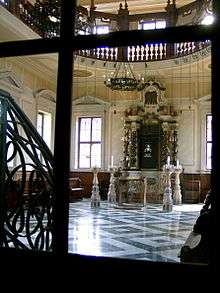
Among those families, Leucius brought his group to Senigallia and settled down there. Leucius was probably born around 1380 CE and it is unclear when he moved from Rome to his new town. At the end of fifteenth century, the family moved out of Senigallia looking for places where their life could be considered less dangerous.
One group moved to Mantua (Daniel and Isac da Senigallia, bankers at la Volta Mantovana)[3] and another led by a H'anna'el Graziadio[4]
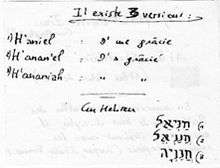
moved firstly to Modena and later to Scandiano, a small village at that time, not far from Modena, under the ownership of the Duke of Ferrara.
They restarted their banking activities and slowly built themselves a favourable situation, including a house, a school and a Synagogue. In 1656 they sold everything to the Almansi family,[5] who came to Scandiano from Spain and the Senigaglia left Scandiano.
From this moment the family divides in three branches:
- The first one goes back to Modena and then eventually return to Senigallia.[6] They also changed their name to Sinigaglia from the previous Senigaglia.
- The second branch ended in Lugo: they became rich merchants and famous goldsmiths. They also changed their name into Sinigaglia[7]
- The third, led by a Baruch (Benedetto) Senigaglia[8] established themselves in Gorizia a small beautiful town 40 kilometres north of Trieste[9]
Genealogy
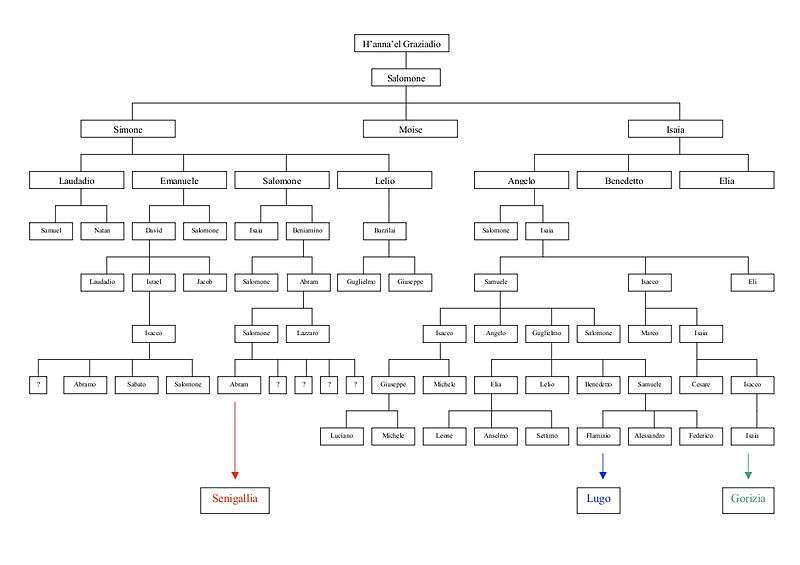
Crests
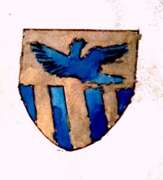
Two crests are known: one of the Lugo branch: a blue eagle flying in a silver background[10]
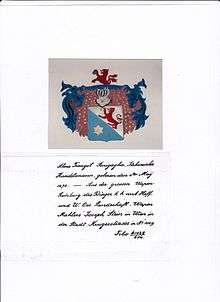
The second belongs to the Gorizia branch. The golden coins seen on the red part of the crest are a family legend: they would have been lent to Napoleon, and never returned. In exchange of the loan, the Emperor would have granted the right of displaying the gold on the crest for as long as the loan was not paid back[11]
Notable individuals
- Izchak ben Avigdor da Senigallia (1491), banker at La Volta Mantovana
- Abraham Senigallia (1632), banker at La Volta Mantovana
- Israel Jacob Senigallia, professor of surgery at the Mantova medical school (1751-1752)
- Abraham Salomon Senigallia (1715) is one of the three leaders of Hadashim labakarim (for sacred studies)
- Solomon Jedidiah Sinigaglia was rabbi and mohel in Scandiano in 1639. Later he went to Modena.[12]
- Abraham Vita Sinigaglia: rabbi of Modena during the first half of 18th century[12]
- Solomon Jedidiah Sinigaglia: rabbi in Modena during the 18th century[12]
- Moises Elijah Sinigaglia (1763-1849) rabbi in Modena[12]
- Graziadio Ghedalia Sinigaglia from Lugo. Famous goldsmith
- Isaac Sinigaglia, last rabbi in Lugo
- Jacob Senigaglia in Gorizia won a tribunal case against the Austrian Empire to obtain the right of ownership of houses and lands outside the Ghetto
- Isaac Senigaglia in Gorizia: banker and silk trader
- Gilberto Senigaglia in Trieste, gynecologist[13]
- Oscar Sinigaglia. Founder of the Italian steel industry[14]
- Leone Sinigaglia, Italian composer.
- Giuseppe Sinigaglia, was the head of KKL in Italy.
See also
References
- ↑ "Fordham University". Medieval Sourcebook: Twelfth Ecumenical Council: Lateran IV 1215. Fordham University. Retrieved 21 February 2012.
- ↑ Senigallia, Sigismondo strongly supported the old Fiera della Maddalena and implemented fiscal aids for those who wanted to establish in the "new town", thus attracting many people from various parts of Italy, among those the core of the subsequent Jewish community who helped to restrengthen the local commerce.
- ↑ V. Colorni, Judaica minore, Milano 1983 and Shlomo Simonshon, History of the Jews in the Duchy of Mantua, Jerusalem, 1977.
- 1 2 As from attached picture, obtained from the Lausanne Jewish Community.
- ↑ Arch. Stato Reggio Emilia (Notarile) Notaio Pegolotti Livio, vol. X, 7 gennaio 1676.
- ↑ Correspondence with Mrs Emma Sinigaglia Foà. Archives Bruno Bersano Senigaglia.
- ↑ Famiglia Sinigaglia (Sinigallia).
- ↑ Marriage contract, dated 20. 10. 1714 between Judita Bolaffio and Jacob Pincherle, with Baruch Senigaglia as witness. Archives Bruno Bersano Senigaglia.
- ↑ Bruno Bersano Senigaglia: La famiglia Senigaglia - Rassegna mensile di Israele, vol. LVII - III serie - 1991.
- ↑ G.A. Pisa: Parnassim, Le grandi famiglie ebraiche italiane dal sec. XI al XIX.
- ↑ Archives Bruno Bersano Senigaglia and tombstones in the Gorizia cemitery.
- 1 2 3 4 Jewish Encyclopedia, Sinigaglia family
- ↑ http://www.retecivica.trieste.it/joyce/vis_articolo.asp?pagina=-&link=26&tipo=articoli_dx_6&ids=3
- ↑ Correspondence with Mrs Emma Sinigaglia Foà (20. 07. 1990). Archives Bruno Bersano Senigaglia.
External links
- http://www.racine.ra.it/curba/_static/materialeStud/ebrei/sinigalia.htm
- Jonathan Senigaglia (American composer) music page
- Giuseppe Tominz, portrait of the Sinigaglia family, 1845